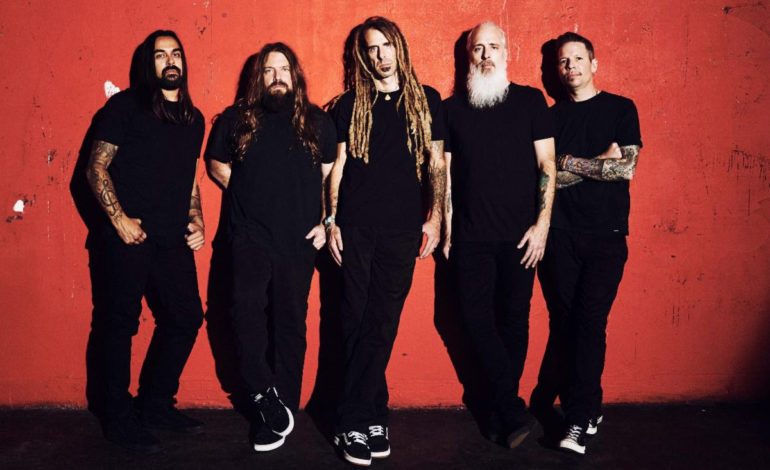

A week after a live stream of their new self-titled release, Lamb of God returned to the virtual realm with a playthrough of 2004’s Ashes of the Wake. Consisting of tight shots from what appeared to be three angles—one stationary overhead and two travelers—bolstered by two minutes in the greenroom before following the band to the stage, LoG brought a sensory assault of shred, riff and grind that, although distanced, felt up close and personal.
The band plowed through the 11 tracks of Ashes of the Wake as the chat box lit up with viewers from around the globe, commenting on the song choices and carrying exchanges that would transcend the concert experience of what feels like yesteryear. To compare real live experience and this version of it gets into uncanny territory, not unlike stadium pro wrestling sans the rabid throng, or baseball games played to digital cardboard cutouts. Metal shows are supposed to include crushing physical context. Not possible here.
Here LoG presented a feed in real time of what used to be seen on VHS tapes sent via post from fanzines for 10 or 20 bucks: Band huddles near a door, members twist their necks and shake out the tension as they gulp from crinkled water bottles until one of them gives the “let’s do this” sign, and leads the pack out to greet the chanting crowd that now explodes with beckoning screams. Cut to wide shot of the stage and then the rush of madness in the first few rows, now enveloped in the stage light as cameras flash in the distant darkened rows. Frontman invites more screams. Cue riffage.
Take away the crowd, and that’s basically what this was. But instead of any visual context of the venue, which would probably have been depressing anyway for such a voluminous powerhouse such as LoG, the shots remained tight, the angles mostly shot on stage. Players filled the screen. Even the large papyrus-font banner rarely had a complete showing. Like many of these concerts, it felt like it could just as easily be taking place in a basement equipped with a suspicious amount of stage lighting.
All that aside, the performance itself displayed LoG’s 20-plus years, well-earned reputation as a leader in post-Pantera American metal. The assault of the first three tracks, “Laid to Rest,” “Hourglass” and “Now You’ve Got Something to Die For” stirred the adrenaline as frontman Randy Blythe growled and screeched. Ashes of the Wake’s construction is well-suited to a live stream format, as the atmospheric shift that introduced “The Faded Line” offered a reflective moment to touch base and take in the nuances of the mix. The hypnagogic plucks and distant wails that brought to mind the impossibly distant polarity of Gary Wright’s proto-yacht rock “Dreamweaver” exploded into the militaristic 1-2-3-4-5 double-kick pulses and chugging, syncopated dual riffs that call to mind both Judas Priest and Metallica’s “One.”
It was here that the camerapeople got a little more daring with their shots. Fisheye and prism lens filters occasionally appeared for little discernible reason, and camera movements became more expressive, possibly to enliven the mood or simulate headbanging with a light-to-moderate buzz. Totally unnecessary. The fans in the chat box seemed more interested in the aurally destructive carnage they were hearing on the mix, which was impressive and no small feat for the short period these sorts of concerts have been happening. The guitar panning meshed well with the visual, which is another element that puts the live stream into a genre of its own, as such a quality could hardly be created in a crowded audience with limited individual movement.
Blythe did finally acknowledge the virtual audience in its domestic setting after finishing out Ashes with its 11th track, “Remorse Is for the Dead:” “Thanks for sticking around in your dining room, your great room, your Florida room” and pointing out that the next day marked 20 years since LoG’s breakthrough, New American Gospel, was released. Starting with the dizzying “O.D.H.G.A.B.F.E.,” about Blythe’s encounter with an overzealous police officer (it’s commonly understood that the acronym stands for “Officer Dick Head Gets A Black Fucking Eye”), LoG closed out the set with a three-song “encore” from New American Gospel. They growled to a close with the stoner slow-grind of “Black Label.” The feed stopped, and as the audience logged off, a few exchanged info on upcoming metal shows as others thanked the host. For all the viscerality and aggression that characterizes the genre, metal fans often express the most camaraderie, whether through devil horns or the social bonding ritual that is the mosh. It’s nice to see that friendly head-butting continue.
Set List:
